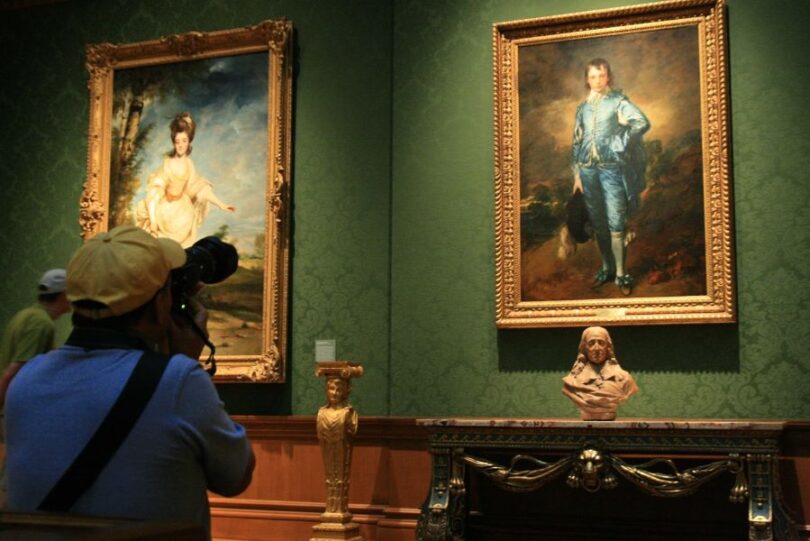When you think of iconic paintings, it’s easy to associate them with the world’s most famous museums. The Mona Lisa is a staple of the Louvre in Paris, and New York City’s MoMA is home to Van Gogh’s Starry Night. Rembrandt’s masterpiece, The Night Watch, draws countless visitors to Amsterdam’s Rijksmuseum.
However, some renowned works of art are housed in more intimate and sometimes unexpected settings. These smaller museums often surprise visitors by offering close encounters with paintings that are as famous as the institutions themselves are modest. If you’re an art lover, these hidden gems offer a chance to see exceptional pieces away from the crowds of larger galleries, where the experience can feel more personal.
From Washington D.C. to San Marino, California, and even tucked away corners of Paris and London, these smaller museums are home to masterpieces that have left lasting marks on art history.
The Phillips Collection, Washington, D.C.

The Luncheon of the Boating Party (1881), Pierre Auguste Renoir by Nrico licensed under CC BY 2.0
Located in the Dupont Circle section of Washington, D.C., The Phillips Collection may not have the size or fame of the nearby National Gallery, but it holds an impressive array of masterpieces that rival those in the world’s biggest museums. One of its most iconic pieces is Pierre-Auguste Renoir’s Luncheon of the Boating Party (1881), which captures a vibrant and leisurely scene of friends dining along the Seine. Renoir’s masterful use of light and color makes this painting one of the most beloved of the Impressionist era.
In addition to this iconic Renoir, the Phillips Collection is home to other standout works, including The Migration Series by Jacob Lawrence. This 60-panel series (1940–41) tells the compelling story of the mass migration of African Americans from the rural South to the urban North, blending social commentary with striking modernist style. Visitors can also admire works from groundbreaking artists like Mark Rothko, Piet Mondrian, and Paul Cézanne, whose series of paintings showcase their evolution and influence on 20th-century art.
Huntington Art Museum — San Marino, California

The Blue Boy by Zeetz Jones licensed under CC BY-NC-ND 2.0
Set among the lush botanical gardens of the Huntington Library and Art Museum in San Marino, California, lies one of the most famous portraits in Western art: Thomas Gainsborough’s The Blue Boy. Painted in the 1770s, this striking image of a young boy dressed in shimmering blue attire is renowned for its vivid color, delicate brushwork, and poised expression. The Blue Boy has captivated viewers for centuries, solidifying Gainsborough’s reputation as one of Britain’s most influential portraitists.
The Huntington’s collection goes beyond this iconic piece, offering visitors a chance to explore a range of European and American artworks. Its galleries feature a notable collection of British art, including works by Joshua Reynolds and stunning examples of 18th-century portraiture. The Huntington provides an immersive experience for art lovers, with its combination of art, literature, and garden spaces creating a serene cultural retreat.
Musée de l’Orangerie — Paris, France

The oval room, Musée de l’Orangerie, Paris by fmpgoh licensed under CC BY-NC-ND 2.0
Tucked away in the Tuileries Garden, the Musée de l’Orangerie is a must-visit for fans of Claude Monet’s Water Lilies series. The museum’s crown jewel is a panoramic display of Monet’s large-scale Water Lilies paintings (1920–1926), which are housed in two oval rooms designed to immerse viewers in the serene beauty of his beloved garden at Giverny. The expansive canvases capture the subtle interplay of light, water, and flora, creating an almost meditative experience as you step into Monet’s world.
While Monet’s works take center stage, the Orangerie’s collection extends to other 20th-century masters. Visitors can admire pieces by Pablo Picasso, Paul Cézanne, and Amedeo Modigliani, whose works represent key moments in modern art. Henri Matisse’s vibrant compositions also grace the museum’s halls, offering a vivid counterpoint to Monet’s tranquil landscapes. With its intimate setting and exceptional range of artworks, Musée de l’Orangerie provides a quiet yet powerful art experience in the heart of Paris.
The Courtauld Gallery — London, England

Manet, A Bar at the Folies-Bergère, 1882 by Steven Zucker, Smarthistory licensed under CC BY-NC-SA 2.0
Housed within the historic Somerset House near the Thames in London, The Courtauld Gallery offers an intimate setting to view some of the world’s most celebrated works of art. Among its highlights is Édouard Manet’s A Bar at the Folies-Bergère (1882), a striking masterpiece that captures the complexities of modern life in Paris. Manet’s detailed rendering of a barmaid standing behind a lavishly stocked counter reflects not only his technical skill but also his keen observation of social dynamics and urban alienation.
The Courtauld is also home to Van Gogh’s evocative Self-Portrait With Bandaged Ear (1889), a haunting glimpse into the artist’s inner turmoil following a personal crisis. Georges Seurat’s Young Woman Powdering Herself (1888-90) offers another standout, showcasing the artist’s innovative pointillism technique in a refined, intimate portrait.
You Might Also Enjoy: Celebrating American Art: Museums Dedicated to Iconic Artists
The Wallace Collection — London, England

Fragonard, The Swing (detail) by Steven Zucker, Smarthistory licensed under CC BY-NC-SA 2.0
The Wallace Collection, housed in a grand London townhouse, is a treasure trove of fine and decorative arts, and among its most famous pieces is Jean-Honoré Fragonard’s The Swing (1767). This quintessential Rococo painting, with its playful depiction of a young woman on a swing, captures the lightheartedness and elegance of 18th-century French aristocracy. Fragonard’s masterful use of color and movement makes The Swing one of the most recognizable and beloved works of its time.
The Wallace Collection also features another iconic portrait, The Laughing Cavalier (1624) by Franz Hals. With its vibrant brushstrokes and expressive detail, this portrait remains one of the most striking images from the Dutch Golden Age. Visitors will also find an impressive selection of British art, including works by Joshua Reynolds and stunning watercolors by J.M.W. Turner.
FAQs:
Q: Are reservations required to visit these museums?
A: Most of these museums do not require reservations, but it’s always a good idea to check their official websites for up-to-date information on ticketing, especially for special exhibitions. Some, like The Phillips Collection and Musée de l’Orangerie, may offer timed-entry tickets to manage crowd flow.
Q: What are the typical entrance fees?
A: Entrance fees vary. The Courtauld Gallery charges around £10-12, while The Phillips Collection suggests a donation. Some museums, like The Wallace Collection, offer free entry. Check each museum’s website for specific details on pricing.
Q: Are these museums family-friendly?
A: Yes, most of these museums welcome families, though younger children may appreciate some collections more than others. Musée de l’Orangerie’s serene Water Lilies room, for example, might appeal to all ages, while The Wallace Collection’s decorative arts can capture a wide range of interests.
Q: How accessible are these museums for visitors with mobility issues?
A: Many of these museums, like The Phillips Collection and The Huntington, offer accessibility features, including ramps, elevators, and accessible restrooms. Be sure to consult each museum’s website for specific accessibility information and services available.
Q: Are photography and sketching allowed inside these museums?
A: Photography policies vary. Most museums allow non-flash photography in permanent collection areas, but some, like Musée de l’Orangerie, may restrict photography in special exhibitions. Sketching is often permitted, though materials like easels may not be allowed. Always check specific museum guidelines before your visit.
Q: Can I find dining options near these museums?
A: Yes, most of these museums are located in areas with plenty of dining options nearby. The Huntington Art Museum, for example, has its own café, while museums in cities like London and Paris are surrounded by a wide range of eateries to suit any taste.
Q: Are there guided tours available at these museums?
A: Many of these museums offer guided tours, either in person or via apps and audio guides. The Courtauld Gallery and The Phillips Collection, for example, offer both guided tours and self-guided audio options to enhance the visitor experience. Check individual museum websites for details.
Have you seen any of these masterpieces in person? Tell us about it in the comments below!
Feature Image: The Huntington Art Gallery: Gainsborough’s Blue Boy by Carlos licensed under CC BY-NC 2.0








